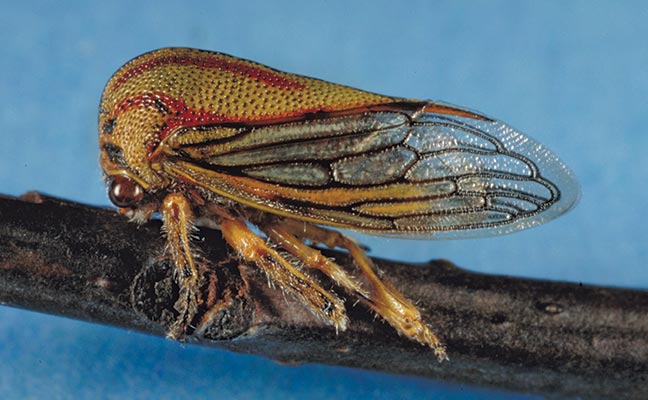Email your questions about insect identification and pest management technologies and techniques to Dr. Doug Mampe at dentomol@aol.com. Your questions most likely will be printed and answered in one of Pest Management Professional’s upcoming Ask the Expert columns.
Q: An office building has treehoppers (Membracidae) collecting along inside windowsills overnight. The windows are sealed and do not open. Is there anything we can do to reduce this problem? This happens every year in the early summer.
— Bob R., Massachussetts

Membracidae insects, such as this oak treehopper (Platycotis vittata), can astound with their ability to get in hard-to-reach areas as the weather gets warmer.
Photo: Larry R. Barber, USDA Forest Service, Bugwood.org
A: You are not alone with this problem. Treehoppers, leafhoppers and midges create a lot of problems. You wouldn’t think the insects could get through sealed windows, but they find a way. Insecticides will kill the insects that enter, but not solve the problem.
Light management is the ultimate solution. Turn off office lights or close light-proof blinds. Reduce light intensity outdoors. If the building is light in color, the problem is worse.
Lights should be mounted away from the building, not on it. Change mercury lights to sodium vapor lights, which are much less attractive to pests.
Q: I have a customer with a bee problem. Bees are nesting in a wall void. I suggested contacting a beekeeper who could remove the bees. I also discussed the importance of removing the old hive and honey. The customer told me he couldn’t find a beekeeper willing to remove the bees. Why wouldn’t the beekeepers help? How do I find a beekeeper willing to do the work? I really don’t want to kill the bees.
— Tom S., Pennsylvania
A: Some beekeepers don’t want a “wild” colony because it might contain diseases or mites, and the beekeeper doesn’t want to infect his colonies. To obtain a list of commercial beekeepers in your state, contact the appropriate state agency — usually the Department of Agriculture — or your local county extension service. Once you find a beekeeper willing to take on such work, save his or her name for future reference.
Q: Small flies are collecting at a window in a three-story townhouse. The window is on the ground floor, which is on a slab. Two other pest management firms told the customer they are drain flies. I’m sending you some samples to make sure they are drain flies. If so,
I suspect a broken waste line under the slab.
— Mike C., Wisconsin
A: The sample contained only fruit flies; they probably are coming from the kitchen area. Fruit flies do not breed in effluent from waste lines. The lesson here is never take someone else’s word for identification, and always have the identification made by someone qualified to be sure you are dealing with the correct species. In this case, breaking up a slab looking for a break in a waste line would have cost the customer money and provided no benefit.
Q: A customer trapped a specimen that was identified eventually as a pseudoscorpion (Pseudoscorpionida spp.). I’ve never seen such a thing. What do they do? Are they dangerous? How do I control them?
— Bo R., Florida
A: Pseudoscorpions are related to true scorpions, but they don’t have tails or stingers. Therefore, they are harmless to humans. Pseudoscorpions feed on small insects such as springtails. They are most often found in dark, damp areas. Almost any common residual insecticide labeled for use on them will work.
Leave A Comment